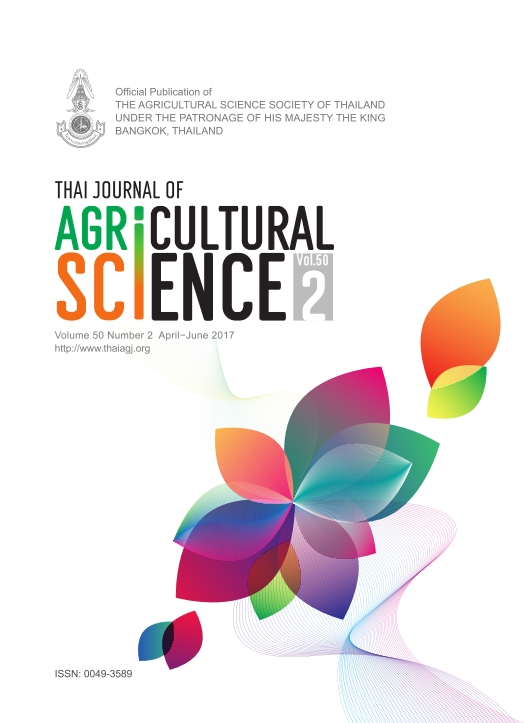Giant Freshwater Prawn (Macrobrachium rosenbergii de Man 1879) Larval Nursing in Relation to Chitosan Levels, Seawater, Artificial Seawater and Re-used Seawater
Main Article Content
Abstract
The experiments were conducted at the Angthong Inland Fisheries Research and Development Center, Angthong Province (Experiments 1.1, 1.2 and 3) and at the Inland Aquaculture Research Institute, Phra Nakhon Si Ayutthaya Province (Experiment 2). These three experiments were carried out during February 2012 to April 2016 aiming to justify the effect due to different levels of supplementary chitosan in feed diet, artificial seawater formulae 1, 2 and the re-used of artificial seawater in nursing giant larval prawns (Macrobrachium rosenbergii). The work also aimed to examine larval prawn overturn postures of its bodies and the survival rate (%). For the Experiment 1.1, five chitosan treatments were used. They included chitosan levels of 0, 100, 200, 300 and 400 ppm for T1 up to T5, respectively. For the Experiment 1.2, the same rates of chitosan as that of Expt. 1.1 together with seawater formula 2 were used and again there were five treatments altogether. The Experiment 2 consisted of the re-used of seawater, artificial seawater formulae 1 and 2. It consisted of three treatments altogether. Experiment 3 consisted of nine treatments on ratio (proportion) between the re-used artificial seawater formula 2 and the unused artificial seawater formula 2 in relation to salinity levels of 9, 12 and 15 ppt. A Completely Randomized Design (CRD) with three replications was used for all of the three experiments. The results showed that a temperature of the culture media of 19°C was not suitable for growth and overturn activity of body postures of the larval prawns. The lowest numbers of days to reach 100 % overturned of larval prawns was found with that of the artificial seawater formula 2 (39 days). A significant effect of chitosan was found with artificial seawater formula 2 at a chitosan level of 100 ppm. This was the most profitable chitosan level for use in culturing larval prawns. The best ratio between the re-used artificial seawater formula 2 and the unused artificial seawater formula 2 plus salinity level was found with T6, i.e., 50:50 plus 15 ppt salinity. A 100% overturned of larval prawns was found with artificial seawater formula 2 at 39 days of age. The ratio between the re-used artificial seawater formula 2 and the unused artificial seawater formula 2 plus 15 ppt salinity level of T6 was the most appropriate treatment.


